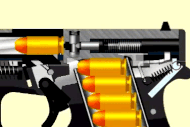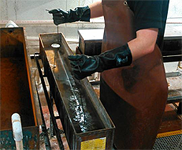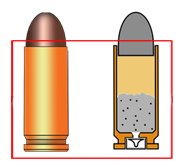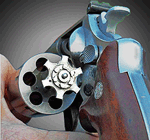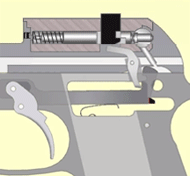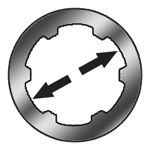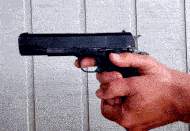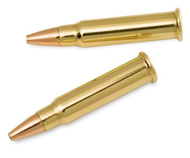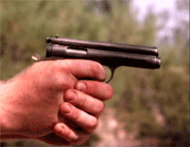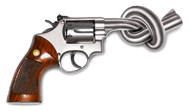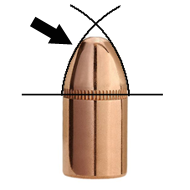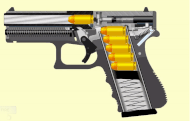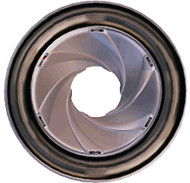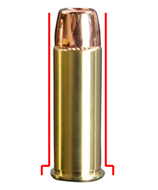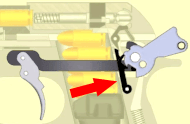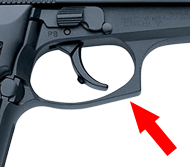ACP
Abbreviation for "Automatic Colt Pistol", a particular type and caliber specification of handgun cartridge. The term comes from a series of auto-loading pistols designed by John Browning for Colt Firearms around the beginning of the 20th century. The cartridges were designed at the time to be specifically used in Colt's new semi-automatic handguns. Most of the original cartridge designs have stood the test of time and are now considered standard and mainstream. Handgun manufacturers continue to build handguns chambered for these cartridges well into the 21st century. The cartridges are distinguished by having a straight casing wall and a groove around the base used by the gun to extract the empty cartridge after being fired. Several newer semi-automatic handgun cartridges employ this design, such as the 10 mm, .40 S&W, and .45 GAP to name a few. But, those cartridges that are designated specifically with "ACP" are based on the original Colt-Browning caliber and cartridge specifications. Today the term "Auto" is often used in place of "ACP", effectively a nickname extracted from the cartridge's formal designation "Automatic Colt Pistol". (see also Caliber, Centerfire)
ACTION
The mechanisms of a firearm involved with presenting the cartridge for firing, and then removing the spent casing and introducing a fresh cartridge. In a semi-automatic pistol this would include items such as the slide, barrel, cartridge magazine, cartridge extractor and ejector, recoil spring and safety components. In a revolver this would include items such as the cylinder, the cylinder advance hand, the cylinder stop, and firing pin transfer bar or hammer block. See our handgun animations for more detail.
AUTOMATIC
A firearm which continues to fire as long as the trigger remains depressed. Machine guns and submachine guns are automatic firearms, as are the M16 and AK47 military assault rifles. There are very few fully automatic handguns, such as the Glock 18, Beretta 93R and the CZ-75 Automatic (shown here). Automatic firearms are not generally available for civilian use.
BACKSTRAP
The rear of two gripstraps on a handgun, which lies beneath the heel of the hand when gripping the gun. In classic handgun designs the gripstraps are formed from the gun's lower frame. Grip panels made of wood or synthetic material are attached to the sides of the frame, leaving the back, bottom and front edges of the metal frame exposed. These frame edges, or "gripstraps" are usually contoured to be comfortable in the hand. Modern firearms can have one-piece polymer grips completely covering the lower frame, or they can have polymer frames altogether where the grips are simply molded-in. In these cases there are no exposed gripstraps and the term "backstrap" simply refers to the rear section of the grip area.
BALL
A military term for standard, full metal jacketed ammunition. The term is thought to have come from either the Revolutionary or Civil War era, possibly referring to the round lead ball fired from muskets, otherwise called a "musket ball".
BALLISTICS
The science of cartridge discharge and the bullet’s flight. External Ballistics deals with the travel of the bullet after it exits the barrel and before it hits the target. It involves factors such as bullet geometry, mass and velocity, air resistance and gravity. Internal Ballistics deals with the bullet's travel in the barrel from the time it is fired till it reaches the end of the barrel. It involves factors such as bullet geometry and mass, pressure and gas expansion, bore diameter and barrel length.
BARREL
The long tubular cylindrical part of a firearm, bored out to provide an exit path for the discharging bullet. The barrel serves the purpose of providing direction and velocity to the bullet.
BLOWBACK
A semi-automatic firearm whose breechblock and barrel are not mechanically locked together when fired. In such case the breechblock immediately begins to separate from the barrel upon firing. A blowback pistol is distinguished by having a stationary barrel that is fixed to the frame. Blowback is used in comparatively low powered weapons, in which inertia of the breechblock, and cartridge wall adhesion against the chamber are sufficient enough to retard opening until breech gas pressures have fallen to a safe level.
BLUING
The chemical process of artificial oxidation (rusting) applied to carbon steel gun parts so that the metal attains a dark blue or nearly black appearance. A common method is hot caustic salt bluing, where gun parts are immersed in a boiling bath of water and corrosive salts.
BORE
The interior of a gun barrel. The term is derived from the process of making the barrel where a hole is literally bored into solid bar stock with a special drill bit to form the inside of the barrel.
BORE DIAMETER
The diameter of the inside of the barrel after boring, but before rifling. The land-to-land diameter. (see also Bore, Lands, Grooves, Rifling)
BOTTLENECK
A type of cartridge whose bullet diameter is substantially less than the body diameter of the casing. The cartridge casing is shaped such that it looks like a small-neck bottle. In many cases a bottleneck handgun cartridge is formed using a straight casing from a larger caliber cartridge. Using a forcing cone and mandrel the casing neck is shaped down to hold a smaller caliber bullet. The intent is to provide greater power to a particular bullet by creating a larger case volume to hold more gunpowder.
BREECH
That portion of the gun that contains the rear chamber portion of the barrel, action, trigger or firing mechanism, and the magazine. (see also Breechblock)
BREECHBLOCK
The part of the weapon that seals the rear of the chamber and supports the casehead when the cartridge is fired. The breechblock also contains the gun's firing pin. Breechloading firearms are classified according to the type of action used, the mechanical means of locking it into place for firing and displacing it for reloading. i.e. “Blowback”, “Delayed Blowback”, and “Recoil” operated actions.
BULL BARREL
A heavier, thicker than normal barrel with little or no taper. Bull barrels are thought to aid in the accuracy of a firearm by adding mass that helps absorb recoil energy and resists barrel lift, and by absorbing heat that could alter barrel geometry as successive rounds are fired through it.
BULLET
The metal projectile, typically in the shape of a round-ended cylinder, expelled from the mouth of a firing cartridge. Often, in slang or layman terms the entire cartridge will be called a bullet, but in fact just the projectile portion of the cartridge is the actual bullet. (see also Cartridge)
CALIBER
The most strict definition of caliber is borrowed from Middle French "calibre", which means "internal diameter of a cylindrical object", such as a gun barrel's bore. Before the advent of the modern firearm cartridge a gun's projectile was a round ball, its diameter made to fit the barrel's bore, or it's caliber. Today's modern cartridges can have many shapes, sizes and powers regardless of the projectile's diameter or the gun barrel's bore. As such, a modern cartridge's caliber now defines its class, dimensions, power, and the type of gun that can use it. The example here shows various cartridges who's projectile diameters are roughly 0.22 inches, or ".22 caliber". But, their caliber descriptions must then include additional information to determine their actual class; i.e. .22 Short, .22 Long Rifle, .22 TCM, .22 Magnum, .22 Hornet, .218 Bee and .223 Remington.
CANNELURE
A groove or indention around the circumference of a bullet. Its purpose is to permit the cartridge casing to be crimped tightly against the bullet shank to hold it firmly to the casing. Not all bullets employ a cannelure. They are mostly found in rifle and revolver bullets.
CARTRIDGE
In modern terms, a round of ammunition consisting of casing, primer, powder and projectile. In the “percussion-cap” era, the cartridge consisted of the projectile and powder in a paper packet, with the primer cap separate.
CASING
A cylindrical tube closed at one end that holds the primer and powder of a cartridge. The cartridge bullet is crimped into the open end of the casing. They are typically made from brass, but can be steel, aluminum, or even plastic.
CENTERFIRE
A cartridge in which the primer or primer assembly is seated in a pocket or recess in the center of the base of the casing (the casing head). Also, refers to a firearm which uses centerfire cartridges. (see also Primer)
CHAMBER
The portion of a pistol barrel or revolver cylinder in which the cartridge is inserted before being fired. Rifles and pistols generally have a single chamber integrated in their barrel, but revolvers have multiple chambers in their cylinder, and no chamber in their barrel.
CHAMBER THROAT
This is the area in a pistol barrel or revolver cylinder that is directly forward of the chamber, which tapers to the bore diameter.
CHARGER/STRIPPER-CLIP
Many early pistol and rifle designs included fixed boxes, or magazines, that would hold multiple rounds of ammo to be fired. Cartridges would be loaded into the fixed magazine through the gun's open breech. A charger, also called a stripper clip, is a device typically made from stamped metal which holds a group of cartridges for easy and virtually simultaneous loading of cartridges into the fixed magazine of a firearm. (see also Breech)
CLIP
This term is often used when referring to a detachable magazine. But in fact, it is a device, usually of stamped metal similar to a charger (see Charger/Stripper Clip) that holds a group of cartridges, and is inserted along with the cartridges into certain guns with fixed magazines. It is expelled after the last round in the magazine is spent. (see also Magazine)
COCK
The term referring to the action of manually drawing the hammer back against its spring until it becomes latched against the sear, or sometimes the trigger itself, arming the hammer to be released by a subsequent pull of the trigger. (see also Hammer, Single-Action)
CYLINDER
A rotating cartridge holder in a revolver. The cylinder also contains the chamber portion of the revolver. Cartridges are held and fired within the cylinder. Cartridge chambers are evenly placed around the axis of the cylinder. The cylinder has a linkage to the firing mechanism which rotates each chamber into alignment with the barrel prior to each firing. (see Hand, Cylinder Stop)
CYLINDER STOP
On a revolver, a spring activated device housed in the bottom of the frame beneath the cylinder that engages alignment notches in the cylinder. It stops the cylinder’s rotation and holds it in place each time a chamber in the cylinder is in alignment with the barrel.
DELAYED BLOWBACK
A self-loading firearm whose breechblock and barrel are not positively locked together, but which incorporates a mechanism which initially restricts the breechblock from moving when fired, delaying its opening. A common method is the use of a gas piston attached to the gun's slide. When the gun is fired the slide begins to recoil, driving the attached piston into a gas chamber. The chamber is pressurized by expanding discharge gasses from the gun's barrel. The pressure retards the piston's rearward motion, delaying the blowback action until the barrel pressure is low enough to safely extract the spent cartridge.
DOUBLE-ACTION (DA)
A revolver or pistol in which a long trigger pull can both cock and release the hammer to fire the weapon. But also, the hammer can be separately cocked and a much shorter trigger pull simply fires the weapon. Alternately called Double Action/Single Action or DA/SA. (see also Single-Action (SA), Double-Action Only (DAO), Cock, Hammer, Hammer Spur)
DOUBLE-ACTION ONLY (DAO)
Typically on spurless-hammer revolvers and pistols, and some striker-fired pistols this refers to a trigger where the firing mechanism cannot be manually or otherwise cocked in a single-action stage. Firing always occurs as a double-action sequence where pulling the trigger both cocks and then fires the gun. (see also Hammerless)
DOUBLE-STACK
A type of semi-automatic pistol cartridge magazine which holds cartridges in two vertical lines. The lines are offset in such a way that cartridges in one vertical line set within the space between cartridges of the other vertical line. The top of the magazine is tapered in such a way that the uppermost cartridge is fed into the pistol, alternating from one vertical line to the other, that cartridge being the next in the offset stack order. The magazine follower is designed with an angle that keeps one vertical line of cartridges a half-cartridge-width higher than the other line which provides the alternating feed order at the top of the magazine. While a double-stack magazine has a higher cartridge capacity it also requires that the pistol grip which houses the magazine to be wider. A double stack magazine will typically hold somewhere between 1.5 to 2 times the number of cartridges in a single-stack magazine of the same caliber. Rarely though is 2 times the number of cartridges achieved as the offset stack magazine follower and associated tapered feed at the top of the magazine use up some of the available space. (see also Magazine, Single-Stack, Follower)
DOVETAIL
A flaring machined or hand-cut slot that is also slightly tapered toward one end. Cut into the upper surface of barrels and sometimes actions, the dovetail accepts a corresponding part on which the sight is mounted.
EJECTOR
The part on a semi-automatic firearm whose function is to throw a spent casing from the gun after firing. It is a stationary blade or pin fixed to the gun's frame. Ir works in conjunction with the Extractor. As the as a spent cartridge case is drawn out of the gun's chamber it strikes the Ejector causing it to flip free from the Extractor and out of the open Breech. (see also Extractor)
EJECTOR ROD
A spring-loaded rod fitted into a housing that typically runs along the bottom-right side of a single-action revolver used to manually eject spent cartridges from the gun's cylinder, one cartridge at a time. (see also Loading Gate, Cylinder)
EJECTOR STAR
Typically on a double-action revolver that has a swing-open cylinder, the collective ejector, manually operated via a rod through the center of an opened cylinder, when activated, clears all chambers of cartridges at once.
EXTRACTOR
On a semi-automatic pistol, a part, normally hooked or claw shaped, attached to the breechblock, which withdraws the spent casing from the chamber when the breechblock separates from the barrel after firing. (see also Ejector)
FIRING PIN
In a hammer fired gun, this is a hardened pin housed in the breechblock, centered directly behind the primer cap of a chambered cartridge. When struck by the hammer it impacts the primer cap of the cartridge, discharging the weapon. (see also Hammer)
FOLLOWER
In a semi-automatic pistol cartridge magazine the follower is a metal plate or plastic block that is attached to the top of the magazine's feed spring which pushes up on the stack of cartridges it holds. The follower keeps the cartridge stack straight as the cartridges are fed into the handgun's chamber each time the pistol is fired. (see also Magazine, Single-Stack, Double-Stack)
FRAME
The common part of a handgun to which the action, barrel and grip are connected.
FRONT STRAP
The part of a revolver or pistol grip frame that faces forward and often joins with the trigger guard. In classic handgun designs the gripstraps are formed from the gun's lower frame. Grip panels made of wood or synthetic material are attached to the sides of the frame, leaving the back, bottom and front edges of the metal frame exposed. These frame edges, or "gripstraps" are usually contoured to be comfortable in the hand. Modern firearms can have one-piece polymer grips completely covering the lower frame, or they can have polymer frames altogether where the grips are simply molded-in. In these cases there are no exposed gripstraps and the term "frontstrap" simply refers to the forward section of the grip area beneath the trigger guard.
GAP
Abbreviation for "Glock Auto Pistol", a type of ammunition and caliber specification. It is a shortened variant of the .45 ACP cartridge, designed specifically for use in a particular compact pistol manufactured by Glock. (see also ACP, Caliber, Centerfire)
GRIP
The handle used to hold a handgun. Often refers to the side-panels of the handle.
GRIPSTRAPS
Classically in metal frame handguns, the exposed portion of a handgun’s frame that provides the foundation for the gun’s grips. Typically, in polymer frame handguns the grips are molded into the frame. In such cases the term "gripstraps" simply defines the front and rear portions of the grips. (see also Front Strap, Backstrap)
GROOVES
Spiral cuts into the bore of a barrel that give the bullet its spin or rotation as it moves down the barrel. (see also Bore, Lands, Twist)
HALF COCK
A position of the hammer in a hammer-activated firing mechanism that acts as a manual safety. When the hammer is manually drawn back far enough that an accidental release could possibly discharge the gun, the half-cock sear is engaged keeping the hammer from falling against the firing pin. The gun will not fire until the hammer is then completely cocked. (see also Sear, Hammer, Cock)
HAMMER
That part of a revolver or pistol that impacts the firing pin or the cartridge directly, discharging the weapon. Its movement is rotational around its axis which is fixed to the frame.
HAMMER SPUR
The thumbpiece on the top rear of the hammer that enables it to be manually drawn back to full cock. All double-action (DA/SA) and single-action (SA) handguns incorporate some form of hammer spur in order to manually cock the hammer. Double-action only (DAO) handguns and striker-fired handguns do not have a hammer spur. (see also Cock, Hammer, Hammerless, Double-Action, Single-Action, Double-Action Only, Striker)
HAMMERLESS
This general term can either refer to revolver or pistol designs that actually have hammers but are fully encased inside the frames, hammer designs where the spurs have been removed for concealment, or striker-fired pistols that are truly hammerless. (see also Double-Action Only (DAO))
HAND
In a revolver the hand is a pawl-like lever that advances the cylinder to the next round when the trigger is pulled, or when the hammer is cocked. The hand presses up against a sprocket at the rear of the cylinder, turning the cylinder until the next chamber is aligned with the barrel. (see also Cylinder, Cock)
HMR
Abbreviation for "Hornady Magnum Rimfire", a type of ammunition and part of a caliber specification. It was developed by necking down a .22 Magnum cartridge case to take a 0.17 inch diameter projectile. (see also Caliber, Rimfire)
LANDS
Raised portions of the bore left between the grooves of the rifling in the bore of a firearm. In rifling, the grooves are usually twice the width of the lands. (see also Bore, Grooves, Twist)
LC
Abbreviation for "Long Colt", a type of ammunition and part of a caliber specification. Associated with the .45 caliber range of bullets. Often referred to simply as ".45 Colt", it is a handgun cartridge dating to 1872. It began as a black-powder revolver round developed for the Colt Single Action Army revolver. (see also Caliber, Centerfire)
LOADING GATE
A covered opening typically on the right side of a single-action revolver who's cylinder is fixed into the frame which allows for the loading and unloading of the cylinder, one cartridge at a time. Spent cartridges are removed form the cylinder through this opening by the use of an ejector rod that runs along the bottom-right side of the gun's barrel. (see also Cylinder, Ejector Rod)
LONG RECOIL
A semi-automatic pistol in which the barrel and breechblock are locked together for the full distance of rearward recoil travel, after which the barrel returns forward, while the breechblock is held back. After the barrel has fully returned, the breechblock is released to fly forward, chambering a fresh round in the process.
LR
Abbreviation for "Long Rifle", a type of ammunition and part of a caliber specification. Associated with the .22 caliber range of bullets. The .22 LR is the most common ammunition in the world today. It is used in a wide range of rifles, pistols and revolvers, (see also Caliber, Rimfire)
MAGAZINE
A tall, slender metal container which holds cartridges under spring pressure to be fed into the gun’s chamber. The magazine typically fits into the pistol's grip. In early pistol designs the magazine was fixed into the frame and had to be loaded through the gun's open chamber.(see Charger/Stripper-Clip) In modern pistols the magazine is detachable, loaded separately and then inserted into the gun at the base of the grip.
MAGNUM
A modern cartridge with a higher-velocity load or heavier projectile than standard.
MAINSPRING
Term often used for the hammer spring.
MISFIRE
A condition when firing a gun in which the cartridge fails to discharge.
MUZZLE
The forward end of the barrel where the projectile exits. (see also Barrel, Muzzle Velocity)
MUZZLE VELOCITY
The speed of the bullet, measured in feet per second or meters per second, as it leaves the barrel.
NECK
The constricted forward section of a bottle-necked cartridge casing – the portion that grips the bullet.
OGIVE
A type of curve represented by the curved section of a bullet between its bearing surface and its theoretical tip.
OPEN FRAME
Refers to a revolver frame that has no topstrap over the cylinder. Also called an open top revolver. (see also Topstrap)
PARKERIZE
A method of protecting a carbon steel surface from corrosion and increasing its resistance to wear through the application of a zinc or manganese phosphate conversion coating. It is considered to be a more effective alternative to bluing, which is an earlier-developed chemical conversion coating. (see also Bluing)
PISTOL
A handgun whose cartridge chamber is integral with the barrel. Refers generally to any handgun that is not a revolver. This includes self-loaders, manual repeaters, single-shots, double or multiple barrel pistols, derringers.
POLYGONAL
Rifling without hard-edged lands or grooves, typically consisting of flat surfaces that meet at angles round the bore . (see also Bore, Grooves, Lands, Rifling, Twist)
PRIMER
A small detonating cap fitted in the head of a centerfire cartridge casing that, when struck by a firing pin, ignites the powder charge. (see also Centerfire, Primer Pocket)
PRIMER POCKET
The counter bore in the center of the base of a centerfire cartridge casing in which the primer assembly is seated. (see also Centerfire, Primer)
PRIMER RING
Refers to a visible dark ring created by the primers in centerfire ammunition around the firing pin hole in the frame after much use. (see also Primer, Primer Pocket)
RECEIVER
In handguns, this refers to the frame. (see also Frame)
RECOIL-OPERATED
Refers to a semi-automatic pistol whose barrel and breechblock both recoil rearward in reaction to the discharging bullet. See “Short recoil” and “Long recoil”.
RIFLING
Typically, a series of spiral grooves cut into the bore of the barrel. Rifling stabilizes the bullet in flight by causing it to spin. Rifling may rotate to the right or left. (see also Bore, Twist)
RIMFIRE
A self-contained metallic cartridge where the percussive igniting compound is contained inside the hollow rim of the cartridge case. The igniting compound is detonated by the firing pin striking the outside edge of the rim, crushing the rim against the rear face of the barrel.
RIMLESS
Refers to a cartridge in which the base diameter is the same as the body diameter. The casing will normally have an extraction groove machined around it near the base, creating a “rim” at the base that is the same diameter as the body diameter. Rimless cartridges are typically used in semi-automatic pistols. (see also Cartridge, Rimmed)
RIMMED
Refers to a cartridge whose rim at its base extends beyond its case diameter. Rimmed cartridges are typically used in revolvers. (see also Cartridge, Rimless)
ROUND
A unit of ammunition consisting of the primer, casing, propellant and bullet. (see also Cartridge) It is thought that the term goes back to the days of musket warfare, where a line of soldiers loaded their muskets, stepped up to a firing line, all fired when given the order and then stepped back to reload. That sequence was called a round. The term evolved to mean any individual discharge of a weapon ("firing a round"), then finally in modern terms a single cartridge not yet fired. Once fired, the cartridge's empty casing is often called a "spent round". The term is also used as a quantity unit (i.e. "a 16-round pistol" or "a 6-round revolver").
SAFETY
A mechanical device built into a weapon intended to prevent accidental discharge. It may be either manually operated or automatic.
SEAR
A pivoting part of the firing mechanism of a gun, either part of the trigger or an intermediate piece, that catches and holds the hammer or striker at full cock. Pressure on the trigger causes the sear to release the hammer or striker, allowing it to strike the firing pin and discharge the weapon. (see also Cock, Half Cock, Hammer)
SELF-LOADER
Another term for semi-automatic. More commonly refers to early designs of semi-automatic pistols. (see also Action, Semi-Automatic)
SEMI-AUTOMATIC
A pistol that is loaded manually for the first round. Upon pulling the trigger, the gun fires. Energy from the discharging bullet is used to eject the fired round, cock the firing mechanism and feed a fresh round from the magazine. The trigger must be released after each shot and pulled again to fire the next round.
SHORT RECOIL
Refers to a semi-automatic pistol in which the barrel and breechblock are locked together for only a short distance of rearward recoil travel, at which point the two are uncoupled, the barrel is stopped and the breechblock continues rearward, extracting the spent casing from the chamber. Upon returning forward, the breechblock chambers a fresh round and forces the barrel back into its forward position. Most modern recoil operated semi-automatic pistols use short recoil.
SINGLE-ACTION (SA)
A pistol or revolver, in which the trigger is only used for firing the weapon, and cannot be used to cock the firing mechanism. On single-action revolvers, the hammer must be manually drawn back to full cock for each shot. On pistols, the recoil action will automatically recock the hammer for the second and subsequent shots.
SINGLE-STACK
A type of semi-automatic pistol cartridge magazine which holds cartridges in a single vertical line with each cartridge directly above the other. This design provides for simple and straight-forward feed mechanics and a narrower handgun grip which houses the magazine, but limits the handgun's overall capacity. A single stack pistol magazine will typically hold no more than eight cartridges. The magazine follower and spring push the stack straight up, feeding each cartridge successively into the pistol's chamber. (see also Magazine, Double-Stack, Follower)
SLIDE
The upper portion of a semi-automatic pistol that houses the barrel and contains the breechblock and portions of the firing mechanism. As its name states, it slides along tracks in the top of the frame during the recoil process providing the linkage between the breechblock and barrel.
SLIDE LEVER
Typically refers to a lever that is actually on a semi-automatic pistol's frame, either on the left or right side, that can perform one or more operations related to the slide. Many pistols have a single slide lever that performs multiple functions: locking the slide open after the last round in a magazine is fired (slide lock), stopping the slide and barrel forward motion after a round is loaded in the chamber and the breech is closed (slide stop) and providing a mechanism for slide and barrel disassembly (slide release). Some pistols may have two slide levers: one just for locking the slide open and another that stops the slide's forward motion (which is also used as a slide release).
SOLID FRAME
Refers to a revolver in which the cylinder window is cut into a single solid piece of frame stock. The construction is neither break-open nor open frame. This type of revolver is loaded be the cylinder flipping out of the solid frame, or by feeding individual rounds into exposed chambers that are rotated out to the side of the frame.
SPEED LOADER
In revolvers in which the entire rear of the cylinder can be exposed for loading, the speed loader is a circular device or clip that holds a complete set of cartridges aligned to insert into all chambers of the cylinder simultaneously.
STRIKER
In a handgun that does not have a hammer, the striker is a linear driven, spring loaded cylindrical part which strikes the primer of a chambered cartridge. The striker replaces both the hammer and firing pin found in hammer driven pistols. (see also Firing Pin, Hammer, Hammerless)
TOPSTRAP
The part of a revolver frame that extends over the top of the cylinder and connects the top of the standing breech with the forward portion of the frame into which the barrel is mounted.
TRAJECTORY
The arc described by a projectile traveling from the muzzle of a gun to the point of impact. (see also Ballistics)
TRIGGER
Refers to the release device in the firing system that initiates the cartridge discharge. Usually a curved, grooved or serrated piece that is pulled rearward by the shooter’s finger, which then activates the hammer or striker.
TRIGGER BAR
On a semi-automatic pistol, or any other firearm in which the trigger is at some distance from the sear, this is an intermediate piece connecting the two parts.
TRIGGER GUARD
Usually a circular or oval band of metal, horn or plastic that goes around the trigger to provide both protection and safety in shooting circumstances. (see also Trigger)
TWIST
The rate at which rifling grooves arc around the core of the barrel, measured in calibers, inches or centimeters. Twists can arc from left-to-right or right-to-left from the rear of the barrel. This is described as either a right-hand or left-hand twist. (see also Bore, Lands, Grooves, Rifling)
WCF
Abbreviation for "Winchester Centerfire", a type of ammunition and part of a caliber specification. It defines a family of cartridges designed by Winchester Repeating Arms Company. There are over thirty cartridge calibers specified as WCF. (see also Caliber, Centerfire)
WMR
Abbreviation for "Winchester Magnum Rimfire", a type of ammunition and part of a caliber specification. Associated with the .22 caliber range of bullets. The .22 WMR uses a larger case than the more popular .22 LR, both in diameter and length, and is slightly more powerful than the .22 LR (see also LR, Caliber, Rimfire)


